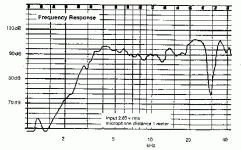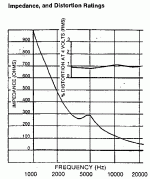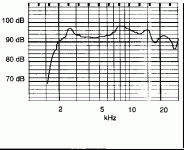Ok, I want to make a speaker that goes from about 40Hz-20KHz, but using phenolic horn drivers. The midrange is easily found, and a horn is easily found as well. The tweeter only goes to 15KHz, and I can't find a small enough horn for it anyway. I need about a 2x6 or smaller. Preferably around there. I thought of using a piezo, but it wouldn't give the same SPL I need (104dB). SO, my question is this: where might I find a reasonably priced 2x6 horn, or where might I find a phenolic tweeter with a frequency range that reaches 17-20KHz? Thanks
Can you really hear a 15,000 Hz tone? Some can, many cannot.
Piezos? Their impedance is so high, you can hook any number up in parallel. Parallel two 92 dB piezos, (or any other driver), and you get 98 dB. Double that to four, and you get 104 dB.
Piezos are cheap. Response varies widely from model to model.
Warning: some people consider piezos terrible, and simply out of the question. I like 'em myself, but not everyone does. Just thought you should know that.
Piezos? Their impedance is so high, you can hook any number up in parallel. Parallel two 92 dB piezos, (or any other driver), and you get 98 dB. Double that to four, and you get 104 dB.
Piezos are cheap. Response varies widely from model to model.
Warning: some people consider piezos terrible, and simply out of the question. I like 'em myself, but not everyone does. Just thought you should know that.
I can actually hear 15KHz... I have a test tone that I DO NOT enjoy hearing. 
And on the parallelling piezos... I thought you only got a 6dB increas when each driver had its own separate power supply. Is this not true here? Could I hook two 98 dB SPL woofers together for 104dB total?
And on the parallelling piezos... I thought you only got a 6dB increas when each driver had its own separate power supply. Is this not true here? Could I hook two 98 dB SPL woofers together for 104dB total?
Originally by tresspasser_guy
Could I hook two 98 dB SPL woofers together for 104dB total?
Following is the formula for power.
Attachments
trespasser_guy said:Ok, I want to make a speaker that goes from about 40Hz-20KHz
Thanks
a good driver choice
maybe not the correct answer for you
but someone might find this tip useful
you can scroll down for some little more info on Focal
halo the great
When you hook two speakers up in parallel, you cut the impedance, (or resistance), in half. Two 8 ohm speakers in parallel become one 4 ohm speaker.
The setting on your amp is for a voltage level. Let's see what happens when we have an amp putting out 2.83 Volts into 8 ohms.
We have (2.83 X 2.83) divided by 8 = 8 Volts divided by 8 Ohms =1 Watt.
Now let's hook up a second speaker in parallel with the first.
We have (2.83 X 2.83) divided by 4 = 8 Volts divided by 4 Ohms = 2 Watts.
Parallel 2 speakers and together you draw twice the current-therefore twice the power-from the amp. At the same voltage drive level. And the SPL goes up 3 dB-partly because of the doubled power, partly because the diaphragm area has just doubled, making the unit, (2 speakers now counts as one unit) more efficient.
Of course, your amp has to be able to supply that extra current. That is why amps state their max power into a certain load-usually either 8 or 4 ohms, lately sometimes 2 ohms.
Piezos, on the other hand, have very high impedance. they draw very little current from the amp as it is. You might have heard that they are very efficient. They are. Yet their SPL's don't seem to be that high. The reason is that they supply the same SPL as a magnetic speaker while drawing much, much less current from the amp. That is why they are efficient.
Below is the impedance and response curve of a piezo tweeter.
The setting on your amp is for a voltage level. Let's see what happens when we have an amp putting out 2.83 Volts into 8 ohms.
We have (2.83 X 2.83) divided by 8 = 8 Volts divided by 8 Ohms =1 Watt.
Now let's hook up a second speaker in parallel with the first.
We have (2.83 X 2.83) divided by 4 = 8 Volts divided by 4 Ohms = 2 Watts.
Parallel 2 speakers and together you draw twice the current-therefore twice the power-from the amp. At the same voltage drive level. And the SPL goes up 3 dB-partly because of the doubled power, partly because the diaphragm area has just doubled, making the unit, (2 speakers now counts as one unit) more efficient.
Of course, your amp has to be able to supply that extra current. That is why amps state their max power into a certain load-usually either 8 or 4 ohms, lately sometimes 2 ohms.
Piezos, on the other hand, have very high impedance. they draw very little current from the amp as it is. You might have heard that they are very efficient. They are. Yet their SPL's don't seem to be that high. The reason is that they supply the same SPL as a magnetic speaker while drawing much, much less current from the amp. That is why they are efficient.
Below is the impedance and response curve of a piezo tweeter.
Here is the response for the Motorola, (CTS) KSN 1016, a 2" X 5" horn, inexpensive. Very smooth response for a piezo, It is 6 dB down at 3000 Hz, ready to cross over to a dynamic driver at that point.
PS: Note that the graph goes up to 40 KHz, not 20 KHz. that big dip in the response is at 30 KHz. This unit goes over 20 KHz.
PS: Note that the graph goes up to 40 KHz, not 20 KHz. that big dip in the response is at 30 KHz. This unit goes over 20 KHz.
Attachments
Here is the impedance graph for the same tweeter. Note how the lowest impedance is at 20 KHz, and it is around 60 ohms.
Incidentally, these are used with a 22 ohm resistor connected in series.
If you parallel 4 of these, the worst you can do is to go down to 20 ohms. I would consider attaching that 22 ohm resistor to each tweeter, for a total of four resistors.
Incidentally, these are used with a 22 ohm resistor connected in series.
If you parallel 4 of these, the worst you can do is to go down to 20 ohms. I would consider attaching that 22 ohm resistor to each tweeter, for a total of four resistors.
Attachments
Here is the frequency response for the KSN 1165. The impedance response chart is unavailable, but the impedance is about half of the KSN 1016's. Be sure to attach a resistor to these, because if you paralled four of them, you will be getting close to an 8 ohm speaker.
In fact, I would parallel only 3 of them, since they are slightly more sensitive than the 1016's.
This is a horn, and it is suitable for crossing over at 2000 Hz. I think it costs about 12 bucks at Parts Express, and is available worldwide. The faceplate is 4" by 4".
Again, piezos are not for everybody, but a lot of people like them. I am one of them.
In fact, I would parallel only 3 of them, since they are slightly more sensitive than the 1016's.
This is a horn, and it is suitable for crossing over at 2000 Hz. I think it costs about 12 bucks at Parts Express, and is available worldwide. The faceplate is 4" by 4".
Again, piezos are not for everybody, but a lot of people like them. I am one of them.
Attachments
Finally, here is a page with some info on some more Piezo models, many of them horns, that you can click on. If you want to use a crossover for the piezo for smoother response, this page shows you how.
The frequency response curves might be from an Australian catalog, but the models are the same worldwide. the entire page is from Andy Graddon, who is a member here.
http://home.iprimus.com.au/gradds/piezos.htm
Also, here is the lineup of piezo drivers from CTS, who took over from Motorola. Don't forget to click on the link to the "application note".
http://www.ctscorp.com/pzt/ffpzt-home.htm
The frequency response curves might be from an Australian catalog, but the models are the same worldwide. the entire page is from Andy Graddon, who is a member here.
http://home.iprimus.com.au/gradds/piezos.htm
Also, here is the lineup of piezo drivers from CTS, who took over from Motorola. Don't forget to click on the link to the "application note".
http://www.ctscorp.com/pzt/ffpzt-home.htm
- Status
- This old topic is closed. If you want to reopen this topic, contact a moderator using the "Report Post" button.
- Home
- Loudspeakers
- Multi-Way
- need driver finding help



